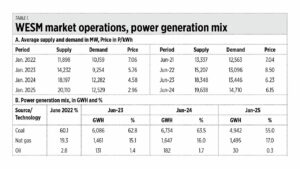Last week, on Feb. 11, the Independent Electricity Market Operator of the Philippines (IEMOP) released the report, “Market Operations Highlights January 2025,” in a media briefing. They also released the monthly prices of the Wholesale Electricity Spot Market (WESM) from June 2021 to January 2025. For the purposes of brevity, I have used the comparative prices in January and June over four years. The prices show a declining trend.
In the power generation mix, coal remains the backbone of electricity production in the Philippines. Solar plus wind contributed only 2.2% of total generation in June 2022, 3.5% in June 2024, and 5.5% in January 2025 (see Table 1).
The anti-coal, pro-wind/solar environmental and business lobbies are misguided if they genuinely want the country to industrialize and create more jobs. Their advocacy to retire coal early will lead to frequent blackouts, and thus to manufacturing companies shutting down and moving to Vietnam, Indonesia, Malaysia, etc. where power supply (mainly from coal plants) keeps rising yearly and where electricity prices are low.
Also last week, on Feb. 13, the Energy Regulatory Commission (ERC) released the report, “Analysis of 2024 Power Generation Rates Yields Downtrend Trend.” They highlighted that “Between 2023 to 2024, ERC noted that the national average annual generation rate dropped by almost 10% from P7.50/kilowatt-hour (kWh) to P6.64/kWh… most areas in the Philippines, except for select regions, saw a significant cut in generation rates in 2024.”
This is good.
But while some regions on certain months have lower generation prices than Metro Manila (which is part of the Meralco franchise area), price is not the only or main criteria if we want the power sector to support sustained economic growth. Very often higher prices, like high body temperatures or fever, are just a symptom and not the cause. The main criteria or consideration should be power stability in order to avoid blackouts, to avoid using candles and gensets.
I saw data from the ERC on two important metrics that measure power stability or instability: the System Average Interruption Duration Index (SAIDI) which is measured in minutes in a year, and the System Average Interruption Frequency Index (SAIFI), or how many times in a year a power interruption occurs. The lower the indices, the better, the more stable the power supply is.
Three situations are considered: Scheduled maintenance; Power supply or grid-related outages like supply deficiency, plant tripping, transmission maintenance, etc.; and All Others which are things like vehicles hitting poles, etc. So I compared the performance of private distribution utilities (DUs) with electric cooperatives (ECs) in the same province or neighboring geographical area using the ERC’s metrics.
For Scheduled maintenance, Meralco’s SAIDI was 51 minutes while Batangas EC (BATELEC) 1’s was 257 minutes (or 4+ hours) and BATELEC 2’s was 1,386 minutes (23 hours).
For Power supply, Meralco’s SAIDI was 26 minutes while BATELEC 1’s was 2,676 minutes (47 hours or nearly two days) and BATELEC 2’s was 1,819 minutes (30 hours).
This is the main reason why many of the mayors in towns in Batangas province which are under BATELEC 1 and 2 wanted their towns to be serviced by Meralco. The price per kWh between the three power providers may be similar but the frequency and duration of blackouts is horrible. The townspeople are inconvenienced and suffer discomfort, their appliances and bulbs are damaged, and they need to use candles or gensets often, and so on. Meralco opted to help BATELEC and other ECs improve their services via technology sharing.
Several mayors also want to be out of the franchise area of Northern Davao EC (NORDECO), formerly Davao North EC (DANECO), and instead have their towns be served by Davao Light and Power Co. (DLPC).
The SAIDI in Power Supply in 2023 for DLPC was 61 minutes while that of NORDECO was 1,256 minutes (21 hours). The SAIDI in 2022 for DLPC was 31 minutes and that of NORDECO was 10,283 minutes (171 hours or seven days).
The same trend between private distribution utilities vs electric cooperatives can be found in Zambales with Subic EnerZone (SEZ) vs ZAMECO; in Cebu with VECO vs CEBECO.
I included in Table 2 North Negros EC (NONECO) because its franchise area includes my birthplace, Cadiz City. The SAIDI of NONECO is bad compared to DUs like VECO, MERALCO, or DLPC.
This column has argued in the past, and will reiterate here, that all ECs should become corporations, or their franchise areas be served by corporate DUs, monitored by the Securities and Exchange Commission (SEC) along with other public service companies like airlines, bus lines, shipping lines, water companies, etc. ECs should not be protected by a political body — the National Electrification Administration (NEA) — and occasionally subsidized by taxpayers via a higher NEA budget.
During the 3rd Ruperto P. Alonzo lecture on the “Energy Trilemma” held on Feb. 7 at the UP School of Economics (UPSE) and organized by the Program in Development Economics Alumni Association (PDEAA), there were two good speakers — Congressman Mark Cojuangco and Eric Francia, CEO of ACEN.
Mr. Cojuangco talked about the virtues of nuclear energy and Mr. Francia talked about the virtues of the retail competition and open access (RCOA) provision of the EPIRA law, among others. While ACEN is gung-ho about having a purely RE portfolio, Mr. Francia is wise enough to recognize the role of coal and gas plants in ensuring the power stability of the country.
The lecture was followed by the PDEAA alumni homecoming, also at UPSE, and we want to acknowledge and thank the National Grid Corp. of the Philippines (NGCP) for its donation, which I failed to mention in this column last week. The NGCP’s role as provider of the transmission backbone and highway between many power plants to DUs, ECs, and retail electricity suppliers is important.
Bienvenido S. Oplas, Jr. is the president of Bienvenido S. Oplas, Jr. Research Consultancy Services, and Minimal Government Thinkers. He is an international fellow of the Tholos Foundation.
minimalgovernment@gmail.com

